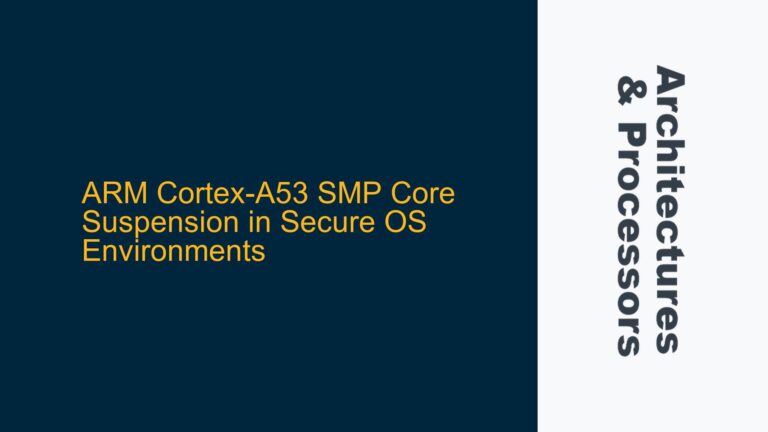ARM Cortex-M33 Firmware Update Over-the-Air (OTA) Architecture
The LPC55S69 microcontroller, based on the ARM Cortex-M33 core, is a powerful and secure platform for embedded applications. One of its advanced use cases is enabling Over-the-Air (OTA) firmware updates, which allow remote updating of the device’s firmware without physical access. Implementing OTA updates on the LPC55S69 involves a combination of hardware capabilities, software architecture, and secure communication protocols. The ARM Cortex-M33’s TrustZone feature, dual-bank flash memory, and secure bootloader are critical components for achieving a reliable OTA update mechanism.
The OTA update process typically involves several stages: receiving the new firmware image via a communication interface (e.g., Wi-Fi, Bluetooth, or cellular), validating the firmware’s authenticity and integrity, storing the firmware in a temporary location, and finally transferring the firmware to the main program memory. The LPC55S69’s dual-bank flash memory architecture is particularly advantageous for OTA updates, as it allows the device to store the new firmware in one bank while continuing to execute the existing firmware from the other bank. This ensures minimal downtime and a seamless transition to the updated firmware.
However, implementing OTA updates on the LPC55S69 is not without challenges. The process requires careful consideration of memory management, secure boot mechanisms, and communication protocols. Additionally, the ARM Cortex-M33’s TrustZone feature must be properly configured to ensure that sensitive operations, such as firmware validation and flash memory writes, are performed in a secure environment. The following sections will delve into the possible causes of issues during OTA update implementation and provide detailed troubleshooting steps and solutions.
Memory Management and Flash Bank Configuration Issues
One of the primary challenges in implementing OTA updates on the LPC55S69 is managing the dual-bank flash memory and ensuring that the new firmware is correctly written to the appropriate bank. The LPC55S69’s flash memory is divided into two banks, Bank A and Bank B, each of which can store a complete firmware image. During an OTA update, the new firmware is typically written to the inactive bank while the device continues to run from the active bank. Once the new firmware is successfully written and validated, the device switches to the updated bank.
A common issue arises when the flash memory banks are not correctly configured or when there is insufficient space to store the new firmware image. This can result in failed firmware updates or even bricking the device if the firmware is corrupted during the update process. Additionally, improper handling of the flash memory can lead to data corruption or loss, especially if the device loses power during the update.
To address these issues, it is crucial to implement robust memory management routines that ensure the new firmware is written to the correct bank and that the firmware image is validated before switching banks. The ARM Cortex-M33’s Memory Protection Unit (MPU) can be used to enforce memory access restrictions and prevent unauthorized modifications to the flash memory. Furthermore, the LPC55S69’s flash memory controller provides features such as error correction code (ECC) and write protection, which can be leveraged to enhance the reliability of the OTA update process.
Another potential issue is the handling of the flash memory’s sector and page boundaries. The LPC55S69’s flash memory is organized into sectors and pages, and writing to the flash memory requires careful alignment with these boundaries. Misaligned writes can result in data corruption or failed writes. To mitigate this, the firmware update process should include checks to ensure that the new firmware image is correctly aligned with the flash memory’s sector and page boundaries. Additionally, the firmware update routine should include error handling mechanisms to detect and recover from failed writes.
Secure Boot and Firmware Validation Mechanisms
The security of the OTA update process is paramount, as any vulnerabilities in the update mechanism can be exploited to inject malicious firmware into the device. The ARM Cortex-M33’s TrustZone feature provides a hardware-based security mechanism that can be used to create a secure execution environment for sensitive operations, such as firmware validation and flash memory writes. However, improper configuration of the TrustZone can lead to security vulnerabilities or failed updates.
A secure boot mechanism is essential for ensuring that only authenticated and validated firmware is executed on the device. The secure boot process typically involves verifying the firmware’s digital signature and integrity before allowing it to execute. The LPC55S69’s secure bootloader can be configured to perform these checks during the boot process, ensuring that only trusted firmware is executed. However, if the secure bootloader is not correctly configured or if the firmware’s digital signature is not properly validated, the device may fail to boot or execute untrusted firmware.
To address these issues, it is crucial to implement a robust secure boot mechanism that includes proper validation of the firmware’s digital signature and integrity. The ARM Cortex-M33’s TrustZone can be used to create a secure environment for performing these checks, ensuring that they cannot be bypassed or tampered with. Additionally, the firmware update process should include mechanisms for securely storing and managing cryptographic keys used for firmware validation.
Another potential issue is the handling of firmware rollback. In some cases, it may be necessary to revert to a previous firmware version if the updated firmware is found to be faulty or incompatible. However, allowing unrestricted rollback can introduce security vulnerabilities, as an attacker could exploit this feature to revert to a vulnerable firmware version. To mitigate this, the firmware update process should include mechanisms for enforcing version control and preventing unauthorized rollback.
Communication Protocol and Data Integrity Challenges
The OTA update process relies on a communication interface to receive the new firmware image. The LPC55S69 supports various communication interfaces, including Wi-Fi, Bluetooth, and cellular, each of which has its own set of challenges. Ensuring the reliability and security of the communication channel is critical for the success of the OTA update process.
One of the primary challenges is ensuring the integrity of the firmware image during transmission. Any corruption or tampering of the firmware image during transmission can result in a failed update or the execution of malicious firmware. To address this, the firmware update process should include mechanisms for verifying the integrity of the firmware image, such as checksums or cryptographic hashes. Additionally, the communication protocol should include error detection and correction mechanisms to ensure that any transmission errors are detected and corrected.
Another challenge is ensuring the security of the communication channel. The firmware image should be encrypted during transmission to prevent eavesdropping or tampering. The LPC55S69’s cryptographic accelerators can be used to perform encryption and decryption operations efficiently, ensuring that the firmware image is securely transmitted. Additionally, the communication protocol should include mechanisms for authenticating the source of the firmware image, ensuring that only trusted sources can initiate firmware updates.
The handling of large firmware images is another potential issue. The LPC55S69’s flash memory has a limited capacity, and the firmware image may be too large to fit in a single transmission. To address this, the firmware update process should include mechanisms for splitting the firmware image into smaller chunks and reassembling them on the device. Additionally, the communication protocol should include mechanisms for resuming interrupted transmissions, ensuring that the firmware update can be completed even if the connection is temporarily lost.
Implementing Data Synchronization and Error Recovery Mechanisms
The OTA update process involves multiple stages, each of which must be carefully synchronized to ensure a successful update. Any errors or interruptions during the update process can result in a failed update or a bricked device. To address this, the firmware update process should include robust error recovery mechanisms that can detect and recover from errors at each stage of the update process.
One of the key challenges is ensuring that the device remains in a consistent state throughout the update process. The LPC55S69’s dual-bank flash memory architecture provides a degree of resilience, as the device can continue to run from the active bank while the new firmware is written to the inactive bank. However, if the update process is interrupted, the device may be left in an inconsistent state, with partially written firmware in the inactive bank. To mitigate this, the firmware update process should include mechanisms for detecting and recovering from interrupted updates, such as maintaining a status flag in non-volatile memory that indicates the current state of the update process.
Another challenge is ensuring that the device can recover from a failed update. If the new firmware is found to be faulty or incompatible, the device should be able to revert to the previous firmware version. However, as mentioned earlier, allowing unrestricted rollback can introduce security vulnerabilities. To address this, the firmware update process should include mechanisms for enforcing version control and preventing unauthorized rollback. Additionally, the device should include a recovery mode that allows it to boot into a minimal firmware image that can be used to restore the device to a known good state.
The handling of power loss during the update process is another critical issue. If the device loses power during the update process, the firmware in the inactive bank may be left in an inconsistent state, resulting in a failed update. To address this, the firmware update process should include mechanisms for detecting power loss and recovering from it. For example, the device could include a small backup power source, such as a supercapacitor, that allows it to complete the update process even if the main power source is lost. Additionally, the firmware update process should include mechanisms for verifying the integrity of the firmware image after power is restored, ensuring that the update can be safely completed.
Conclusion
Implementing OTA updates on the LPC55S69 microcontroller involves a combination of hardware capabilities, software architecture, and secure communication protocols. The ARM Cortex-M33’s TrustZone feature, dual-bank flash memory, and secure bootloader are critical components for achieving a reliable OTA update mechanism. However, the process is not without challenges, including memory management, secure boot mechanisms, and communication protocol issues.
By carefully addressing these challenges and implementing robust error recovery mechanisms, it is possible to achieve a reliable and secure OTA update process on the LPC55S69. The key is to leverage the microcontroller’s hardware features, such as the dual-bank flash memory and TrustZone, while also implementing robust software routines for memory management, firmware validation, and error recovery. With the right approach, the LPC55S69 can be a powerful platform for enabling remote firmware updates in embedded applications.






